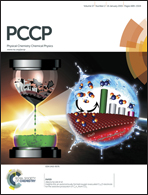Efficiency of ruthenium dye sensitized solar cells enhanced by 2,6-bis[1-(phenylimino)ethyl]pyridine as a co-sensitizer containing methyl substituents on its phenyl rings
Abstract
2,6-Bis[1-(phenylimino)ethyl]pyridine (M0) and its derivatives containing methyl groups on their phenyl rings (M1o, M1p and M2) are employed as co-sensitizers in dye-sensitized solar cells (DSSCs). The prepared co-sensitizers could alleviate the aggregation of ruthenium dye N719 on the TiO2 film, enhance the spectral responses of the co-sensitized TiO2 film in the region from 400 to 750 nm, suppress the electron recombination, prolong the electron lifetime and decrease the total resistance of DSSCs. The number and position of the methyl groups are two key factors that play important roles in the performances of DSSCs. The optimized cell device co-sensitized by the M1p/N719 dye gives a short circuit current density of 16.48 mA cm−2, an open circuit voltage of 0.72 V and a fill factor of 0.62 corresponding to an overall conversion efficiency of 7.32% under standard global AM 1.5 solar irradiation, which is 35% higher than that of a device solely sensitized by N719 under the same conditions.
![Graphical abstract: Efficiency of ruthenium dye sensitized solar cells enhanced by 2,6-bis[1-(phenylimino)ethyl]pyridine as a co-sensitizer containing methyl substituents on its phenyl rings](/en/Image/Get?imageInfo.ImageType=GA&imageInfo.ImageIdentifier.ManuscriptID=C4CP04240A&imageInfo.ImageIdentifier.Year=2015)

 Please wait while we load your content...
Please wait while we load your content...